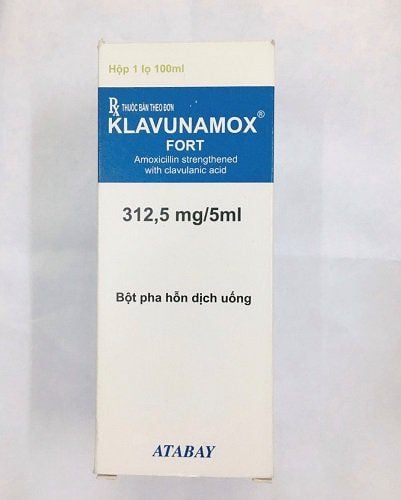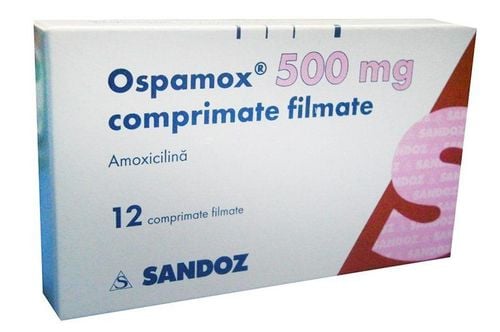This is an automatically translated article.
Amoxicillin is a very commonly used broad spectrum antibiotic. However, current strains of bacteria that secrete β-lactamases are resistant to Amoxicillin and require conjugation with clavulanic acid. A product that has both active ingredients is the drug Klavunamox.
1. What is Klavunamox?
Klavunamox is an antibiotic, prepared in powder form for oral suspension and packaged in 1 vial containing 70ml. Ingredients in each 5ml of antibiotic Klavunamox, including:
Main active ingredients include Amoxicillin trihydrate equivalent to 400mg of antibiotic Amoxicillin and Potassium clavulanate equivalent to 57mg Clavulanic Acid; Excipients include Hydroxypropyl methyl cellulose, AL-1 type syloid, Xanthan gum, sodium saccharin crystal, raspberry powder, aerosil 200;
2. Pharmacological characteristics of the antibiotic Klavunamox
2.1. Pharmacokinetics Amoxicillin is a semi-synthetic, β-lactam antibiotic with a broad spectrum of activity against both Gram-positive and Gram-negative bacteria. Amoxicillin's mechanism of action is inhibition of bacterial cell wall synthesis. However, this antibiotic is easily destroyed by the enzyme β-lactamase, so it loses its ability to kill bacteria with strains that produce this enzyme. Clavulanic acid is another major component of Klavunamox, which is the result of fermentation by Streptomyces clavuligerus with a β-lactam structure that is similar to that of penicillin. Clavulanic acid can inhibit the enzyme β-lactamase produced by most strains of Gram-negative bacteria and staphylococcus (Staphylococcus). In particular, this active ingredient has the ability to strongly inhibit plasmid-transmitted β-lactamases that cause resistance to penicillin and cephalosporin antibiotics. The clavulanic acid in Klavunamox helps to prevent amoxicillin from being destroyed by β-lactamase enzymes, and at the same time effectively extends the antibacterial spectrum to many bacteria normally resistant to amoxicillin, other penicillins and cephalosporins. .
Therefore, it can be considered that the drug Klavunamox is effective against bacterial strains such as pneumococcal (Pneumococcus), streptococcus (beta-hemolytic Streptococcus), staphylococci (Staphylococcus that is still sensitive to penicillin is not affected by penicillinase), Haemophilus influenzae and Branhamella catarrhalis, including those that are strong producers of β-lactamases.
2.2. Pharmacokinetics Amoxicillin and clavulanate contained in Klavunamox are both readily absorbed orally. Maximum plasma concentrations of both are reached 1 - 2 hours after administration of Klavunamox.
At a dose of 250 mg (or 500 mg) there will be 5 mcg/ml (or 8-9 mcg/ml) of amoxicillin and about 3 mcg/ml of clavulanate in serum. After 1 hour of oral administration of 20 mg/kg of amoxicillin and 5 mg/kg of clavulanic acid, there was an average of 8.7 mcg/ml of amoxicillin and 3.0 mcg/ml of clavulanic acid in serum. The absorption of Klavunamox is not affected by food, however, it is best taken immediately before meals.
Oral bioavailability of amoxicillin is about 90% and clavulanic acid is about 75%. The serum half-lives of amoxicillin and clavulanic acid are approximately 1 - 2 hours and 1 hour, respectively.
In terms of elimination characteristics, about 50 - 70% of amoxicillin and 30-40% of clavulanic acid are excreted in the urine in the active form.

Amoxicillin và clavulanat có trong thuốc Klavunamox đều có thể dễ dàng hấp thu qua đường uống
3. Indications and contraindications of antibiotics Klavunamox
Klavunamox is indicated for use in the following infectious diseases:
Upper respiratory tract infections: Including sinusitis, tonsillitis, otitis media and some other ear-nose-throat infections; Lower respiratory tract infections: Including acute and chronic bronchitis, pneumonia, empyema, pulmonary abscesses; Skin and subcutaneous soft tissue infections such as nails, boils, abscesses, cellulitis, wound or intra-abdominal infections; Genitourinary infections such as cystitis, pyelonephritis, urethritis, pelvic infection, syphilis, gonorrhea; Osteomyelitis. The antibiotic Klavunamox is contraindicated (contraindicated) in people with a history of allergy to amoxicillin or other penicillins.
4. Instructions for dosage and how to use Klavunamox
Before taking, shake the vial thoroughly with the following dosage:
Adult dose:
25/3.6 mg/kg body weight/day for mild to moderate infections; 45/6.4 mg/kg body weight/day for more severe infections. Dosage of Klavunamox for children older than 2 years:
Dose 25/3.6 mg/kg body weight/day: 2-6 years old (13kg - 21kg): Take 5ml of Klavunamox 400/57mg twice a day; 7 - 12 years old (22kg - 40kg): take 10ml of Klavunamox 400/57mg twice a day; Dose 45/6.4 mg/kg body weight/day: 2-6 years old (13kg-21kg) orally 10ml of Klavunamox 400/57mg twice a day; 7 - 12 years old (22kg - 40kg) orally 10ml of Klavunamox 400/57mg twice a day Children under 2 years old use Klavunamox with a dose based on weight.
How to use Klavunamox antibiotics:
Klavunamox 400/57mg is best absorbed when taken right before meals; The duration of treatment depends on the doctor's prescription and should not exceed 14 days; Before drinking, add water up to the mark on the vial and shake vigorously so that the powder is completely dissolved.
5. Some notes when using Klavunamox medicine
Reports indicate a low incidence of serious, potentially fatal anaphylaxis with penicillin group antibiotics. This phenomenon is more likely to occur if the patient has a history of hypersensitivity to penicillins and/or various allergens. There have been reports of people allergic to penicillin experiencing serious cross-reactions when taking cephalosporin antibiotics. Therefore, before using Klavunamox, it is necessary to carefully review the patient's history of allergies, including allergies to penicillins, cephalosporins or other agents.
Although the penicillins have very low toxicity, to ensure safety, it is necessary to evaluate the function of organs periodically during the use of Klavunamox, including liver function, kidney function, hematopoietic ability;
During treatment with Klavunamox, there is still the possibility of superinfection with bacteria or fungi. If superinfection occurs (usually Pseudomonas or Candida), the patient should be discontinued and appropriate treatment instituted.
6. Undesirable effects of Klavunamox
Common adverse reactions of the antibiotic Klavunamox are diarrhea, nausea, vomiting, rash, urticaria or vaginitis. The possibility of harmful effects, especially diarrhea, is increased when the patient takes higher than recommended doses. Some less common side effects, including abdominal discomfort, bloating, headache;
Hypersensitivity reactions including rash, urticaria, pruritus, erythema multiforme; More rarely are hyperactivity, agitation, anxiety, insomnia, confusion and/or dizziness.

Phản ứng có hại thường gặp của thuốc kháng sinh Klavunamox là tiêu chảy
7. Interaction with other drugs of Klavunamox
Probenecid may decrease the renal tubular elimination of amoxicillin. Therefore, when co-administered leads to increased blood concentration of amoxicillin and prolongation of elimination time; The combination of allopurinol with ampicillin (a penicillin antibiotic) has a higher risk of rash compared with ampicillin alone. The mechanism of this drug interaction is unknown and there are no data on the combination of allopurinol with Klavunamox; Klavunamox may cause prolongation of bleeding and clotting time, so it should be used with caution in patients being treated with anticoagulants; Similar to other broad-spectrum antibiotics, Klavunamox may reduce the effectiveness of oral contraceptives, so it is important to inform patients in advance.
8. Some other notes when using Klavunamox
Women in pregnancy: There is no accurate evidence about the safety of Klavunamox when used for this object, so only use it when absolutely necessary; Semi-synthetic penicillin antibiotics can be excreted in breast milk, so caution should be exercised when Klavunamox is administered to a nursing woman; Cases of excessive use of Klavunamox may be less harmful because of its good tolerability even at high doses. However, hyperkalemia inevitably occurs with very high doses because clavulanic acid is administered as the potassium salt. Klavunamox is an antibiotic indicated for the treatment of a number of bacterial infections. To ensure effective treatment and avoid side effects, patients need to take medicine according to prescription or consult a doctor or pharmacist.
Follow Vinmec International General Hospital website to get more health, nutrition and beauty information to protect the health of yourself and your loved ones in your family.
Please dial HOTLINE for more information or register for an appointment HERE. Download MyVinmec app to make appointments faster and to manage your bookings easily.













